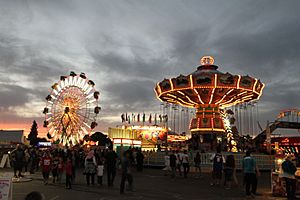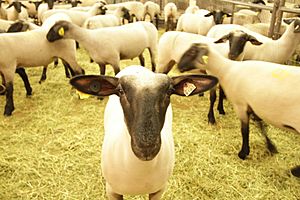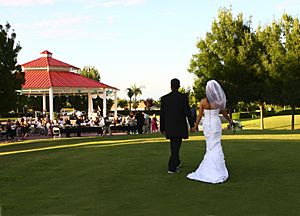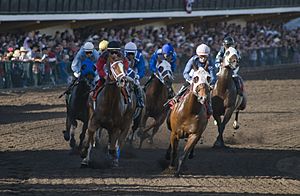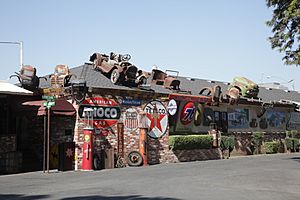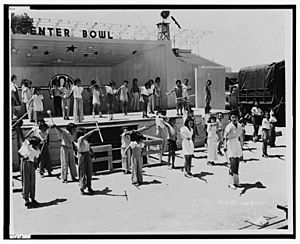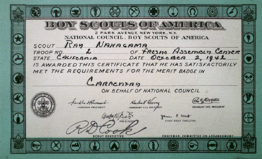The Big Fresno Fair facts for kids
The Big Fresno Fair is a super fun event that started way back in 1884! It's one of the biggest fairs in California, attracting over 600,000 people every October. For two weeks, you can enjoy cool exhibits, see farm animals, watch exciting horse races, listen to live music, and learn new things. The Fair helps people from cities and farms connect and learn about California's amazing farming history. Its main goal is to "Educate, Celebrate and Have Fun!"
The place where the Fair happens, called the Fresno Fairgrounds, is busy all year round. It's a huge area, about 165 acres, and hosts more than 250 events like big meetings, shows, and parties in Fresno, California. Over 1.5 million people visit the Fairgrounds every year! The Fairgrounds pays for itself through these events and kind donations; it doesn't get money from the state for its daily operations. In 2020, the Fair was held online because of the COVID-19 pandemic, but it has been canceled before, like during World War I and World War II.
Contents
Explore the Fairgrounds: Buildings and Spaces
The Fresno Fairgrounds has many large buildings and a cool outdoor amphitheater called the Table Mountain Rancheria Park and Pavilion. These spaces are used for all sorts of events throughout the year, not just the Fair!
Here are some of the main buildings and areas you can find at the Fresno Fairgrounds:
- Agriculture Building: A big space for farm-related exhibits.
- Commerce Building: Another large hall for different shows.
- Fine Arts & Photography Building: Where you can see amazing art and photos.
- Gem & Mineral Building: Discover cool rocks and shiny minerals here.
- Industry Commerce Building: More space for various displays.
- Junior Exhibit Building: Often used for younger participants' projects.
- Livestock Pavilion: Where farm animals are shown.
- Paul Paul Theater: A large theater that can hold 5,000 people.
- Table Mountain Rancheria Park: An outdoor park area.
- The Greenhouse: A large building, great for many types of events.
- Turf Club – Brian I. Tatarian Grandstand: A special area for watching races.
Horse Racing Excitement
Horse racing has been a part of the Big Fresno Fair since it first started in 1883! Back then, local farm owners would race their horses.
Today, the Big Fresno Fair's horse track is known as one of the fastest in California. More than 500 horses come to compete during the nine days of racing. Over the last ten years, a lot of money has been spent to make the horse racing area even better, including new parts for the grandstand where people watch. The Fairgrounds also has two places where people can watch and bet on horse races all year long, even when the Fair isn't happening!
Fun Events All Year Round
The Fresno Fairgrounds is a busy place, hosting over 250 events every year! Besides the Big Fresno Fair, you can find dog shows, roller derby games, home and garden shows, and concerts.
Some of the big annual events include:
- Flea Market And Swap Meet: You can find this market almost every week, on Thursdays, Saturdays, and Sundays. It's a great place to discover unique items!
- Home Shows: There are three different home shows each year – one in spring, one in summer, and one in fall. They feature all sorts of things for your home and garden.
- Hmong International New Year: This huge celebration brings over 100,000 people from all over the world to the Fairgrounds. You can see Hmong arts and crafts, enjoy entertainment, and even watch traditional games like pov pob.
Discover History at the Museums
In 2013, the Big Fresno Fair opened its very own museum! It's called The Big Fresno Fair Museum and is located in O'Neill Hall. This museum tells the story of the Fair, Fresno's farming history, and the city of Fresno. It has over 2,600 items, including photos by a famous American photographer named Pop Laval.
Later, in 2014, a video series called "Heritage Talks" was added. It shares stories from people who have worked at the Fair, like staff members and horse racing fans. In 2015, the museum got even bigger, adding a new building for the Fresno County Historical Museum. In 2018, an exhibit about the history of boxing was also added.
Awards and Recognition
The Big Fresno Fair has won many awards for being innovative and excellent. It received the Merrill Award in 2007, 2012, and 2015. This award is given by the Western Fairs Association for being creative and showing great leadership. The Fair has also won many Gold Star and Achievement Awards.
Important History: Fresno Assembly Center
During World War II, the Fresno Fairgrounds was used as a temporary camp. This was part of a sad time in history when many Japanese Americans living in California were forced to leave their homes and live in special camps. This happened because of an order called Executive Order 9066.
From May to October 1942, over 5,000 Japanese Americans from Fresno and nearby areas were held at the Fresno Assembly Center. They stayed there until more permanent camps could be built in isolated places like Manzanar and Tule Lake. A special memorial, California Historical Landmark #934, is at the Fairgrounds to remember this important part of history. It lists the names of everyone who was held there and includes photos and stories from families who experienced it.
After the Assembly Center closed, the Fairgrounds became a training center for the United States Army Air Forces during the war. It was a place where new soldiers got their first training. This training center closed in 1946.


